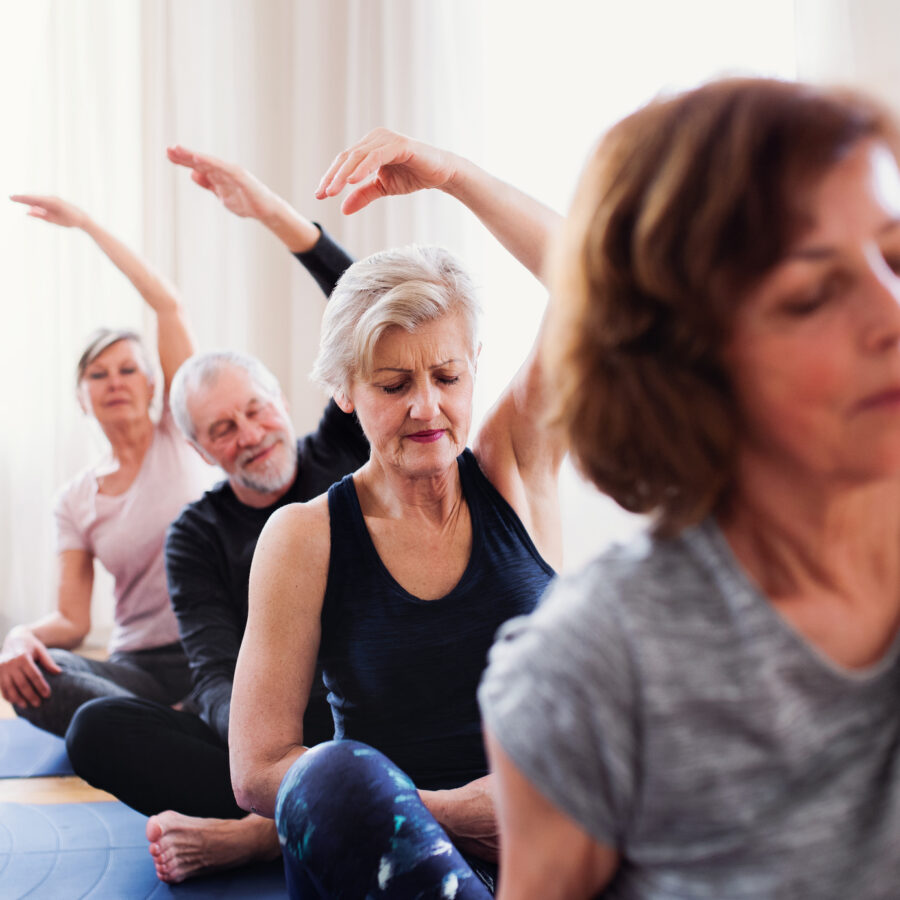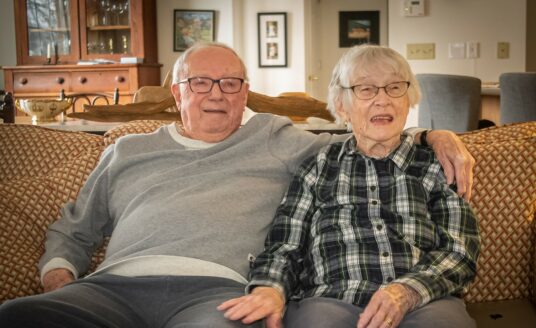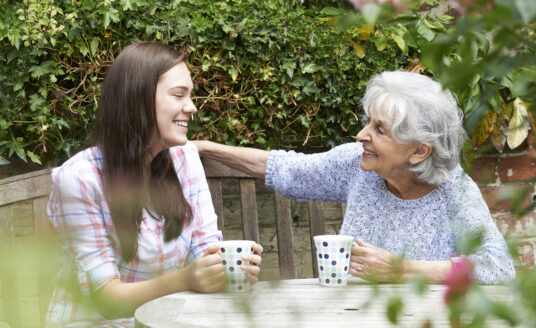Passive, slow movements performed in low light bring deep relaxation.
Creaky joints? Sore muscles? Got that crunchy, “short” feeling that comes with arthritis and plagues people who sit a lot, either at work, in front of the TV or on the floor with grandkids? Then restorative yoga may be the solution for you.
Not to mention, restorative yoga can make you taller.
OK, maybe not in actual inches, but after a class, the body feels lengthened, loosened, and at ease. Plus, if you relax into the supported poses, banish your busy thoughts and embrace doing absolutely nothing, your mind emerges calm and refreshed.
I speak from experience.

Photo by Thinkstock
Other forms of yoga are tough for some elders, but almost everyone can do restorative yoga. Restorative yoga is performed with passive poses in low light and on the floor. To help support your body, make it comfortable, and keep it warm, you can use bolsters, blocks and blankets. Each pose is held for 10 to 20 minutes, allowing time for the body and mind to relax.
“I yawn after the first 15 minutes, and restorative yoga class also relieves my lower back pain,” a 56-year-old devotee told his teacher. “It’s the perfect way to wipe away all the stress of the workweek.”
Some consider the classes a place to regroup while recovering from an accident, an illness or cancer treatments. Others find them a big help during the transition into retirement.
Our Mantra: ‘No Rushing’
“Restorative yoga gives us permission to switch from doing to being — and these days, all of us are conditioned to over-doing,” says Kitty Daly, a partner and teacher at Big Bend Yoga in a suburb of St. Louis, Mo. “People tell me the class is a sanctuary for them, a place where they can close their eyes and enter their own world.”
Daly has offered the 90-minute class once a week on a drop-in basis since 1997.
“It has never lost its appeal,” Daly says. “I prepare the room, open the door and make sure people have what they need. Our mantra every Friday night is ‘no rushing.’” That works for most students, Daly says, except a few who find the slow pace of the class frustrating.
Popularizing Restorative Yoga
Judith Hanson Lasater of San Francisco, California has spent her career working to popularize restorative yoga. A physical therapist and yoga teacher since 1971, Lasater has trained countless yoga teachers in 47 states and more than a dozen countries, teaching them all to guide students through restorative yoga’s gentle poses.
Lasater is also the president and a cofounder of the California Yoga Teachers Association, a founder of Yoga Journal and the author of eight books, including the classic book on restorative yoga, Relax and Renew: Restful Yoga for Stressful Times. (If you can’t get to a restorative yoga class, the book will help you do the poses on your own.)
‘Not a Luxury, Not Laziness’
Rest, Lasater says, is different from sleep.
“You can sleep and not be rested, but 20 minutes of lying on the floor with your legs up on a chair allows you to disconnect, to drop into the parasympathetic nervous system, to rest and repair,” Lasater says. “This is not a luxury, not laziness. It’s imperative in our crazy world that we reduce our stress. You cannot be relaxed and anxious at the same time, and when you are rested, everything in your life is better.”
Restorative yoga is beneficial for older people and people with physical limitations, Lasater says. At 68 years old, she likes the supported yoga poses for a different reason.
“This is a rich, full, wonderful time of life, and I tend to get really busy with teaching, writing and my grandchildren,” she says. “After running around like a maniac, I need this touchstone, this taking time to rest deeply.”
Use of Props
From her yoga teacher, B.K.S. Lsyengar, Lasater learned how props in yoga “can help the pose come to the students,” rather than expecting students to reach for a pose, especially individuals with physical limitations. Inspiration to use those props in low light, working on the floor, came to Lasater as a happy accident.
“One night in the 1980s, the electricity went out as I was teaching a yoga workshop in Canada. We had enough light to be safe, so I asked the students to take bolsters and lie over them,” Lasater recalls. “That felt so good, we moved on to another supported pose. We did a whole restorative class, though it didn’t have that name then. Over the years, it became more and more part of my life. It is so good for the body.”
“Better Than Massage”
Margi Young, a longtime yoga teacher who has taught on both coasts and now works in the San Francisco Bay Area, agrees. “The most relaxing thing I can do for my body and mind is restorative yoga,” Young says. “When I emerge from a pose, I feel restored in a way that surpasses a nap or even a massage.”
In her classes, Young aims to create a safe environment and help students become as comfortable as possible. “After we settle into a pose, I offer a few comments about how to soften the body and what to do with the potentially busy mind,” she says. “Then I become still so the yoga can do its magic.”
Tips for Finding Classes
If you get in on the magic of restorative yoga class, it is recommended that you first figure out if you have the patience for lying still for an extended period of time. First, stretch out on the floor with a pillow under your head. Bend your knees, lift your legs and rest them up on the couch. Close your eyes and breathe deeply. (One teacher calls this “instant Maui.”) Stay there as long as you like.
If you enjoyed the pose and find you have the patience for it, the next step is to find a reliable class:
- Search online for restorative yoga classes in your area
- Call nearby yoga studios, YMCAs or fitness centers.
- Ask your community about available classes
If membership is required for a class, ask whether you can observe a session before joining. You may be surprised at how much you’ll like the class. At the first class I attended, I placed the mat I was given next to the door, in case I wanted to surreptitiously crawl out before the session ended. I didn’t.
If you don’t find a class at a time and place that suits you, you can seek out Lasater’s book, look for DVDs, or YouTube videos featuring restorative yoga. Then make an appointment with yourself to spend 20 minutes or more each day relaxing and renewing. You’re worth it.
Find More Senior Health Tips Today
Call Bethesda at (314) 800-1911 for More Information
Related Articles
How Seniors Can Stay Active During the Winter
Ballet Improves Body and Mind for Seniors
A Life Well Balanced at Bethesda Gardens
Copyright© 2014 Next Avenue, a division of Twin Cities Public Television, Inc.
| Whether in independent living, assisted living, memory care, or skilled nursing, Bethesda offers the right amenities, services, programming, and staff to make every day full of purpose. See for yourself and tour our independent living communities, including Bethesda Barclay House – Clayton, Bethesda Gardens – Kirkwood, Bethesda Orchard – Webster Groves, Bethesda Terrace – South County, Village North Retirement Community – Florissant, and The Oaks at Bethesda Villas – Kirkwood/Webster. |



